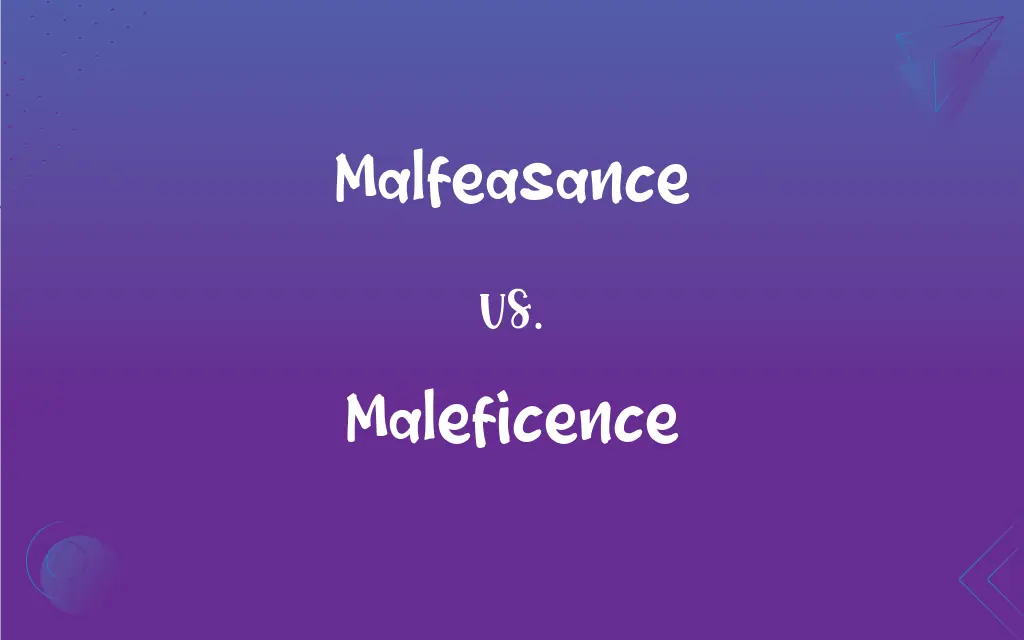Malfeasance vs. Maleficence: What's the Difference?
By Aimie Carlson & Janet White || Updated on May 22, 2024
Malfeasance refers to wrongful or illegal actions, especially by a public official, while maleficence means causing harm or evil, typically with intent.

Key Differences
Malfeasance is a legal term that describes wrongful conduct or illegal actions, especially by a public official. It involves the violation of laws or ethical standards, often resulting in legal consequences. Maleficence, on the other hand, refers to the act of causing harm or evil. It is broader and less specific to the legal context, encompassing any harmful or malicious behavior.
Malfeasance often implies a breach of duty or trust, particularly in a professional or official capacity. It is closely monitored in fields like public administration, corporate governance, and law enforcement to ensure accountability and integrity. Maleficence, while not limited to professional misconduct, underscores the intent to do harm. It can occur in various contexts, including personal relationships, social interactions, and broader societal behaviors. The key aspect is the malevolent intent behind the actions.
In cases of malfeasance, legal frameworks are in place to address and rectify the wrongdoing. Investigations, prosecutions, and penalties are typical responses to ensure justice and uphold ethical standards. Maleficence, although it may not always involve legal action, can have significant social and moral implications. It often leads to a breakdown of trust, conflicts, and a negative impact on the community or individuals affected by the harmful actions.
Comparison Chart
Definition
Wrongful or illegal actions by officials
Causing harm or evil intentionally
Context
Legal and professional
General, broad, and often personal
ADVERTISEMENT
Examples
Bribery, fraud by a public official
Spreading malicious rumors
Implications
Breach of duty, legal consequences
Moral and social consequences
Scope
Specific to roles and responsibilities
Broad, encompassing various contexts
Accountability
Legal frameworks and penalties
Social and moral accountability
Malfeasance and Maleficence Definitions
Malfeasance
Actions violating ethical standards in a professional role.
The CEO’s malfeasance included manipulating financial reports.
ADVERTISEMENT
Maleficence
Behavior characterized by malevolent intent.
The character's maleficence made her the antagonist in the story.
Malfeasance
Wrongful or illegal conduct by a public official.
The mayor was charged with malfeasance for embezzling city funds.
Maleficence
The act of causing harm or evil intentionally.
His maleficence was evident in his deliberate attempts to sabotage her career.
Malfeasance
Breach of duty leading to legal consequences.
The officer’s malfeasance resulted in his dismissal from the force.
Maleficence
Actions that lead to harm without breaking specific laws.
Gossiping with the intent to harm someone’s reputation is an example of maleficence.
Malfeasance
Corrupt practices within an official capacity.
Investigators uncovered malfeasance in the awarding of contracts.
Maleficence
Harmful behavior in personal or social contexts.
Bullying in schools is a form of maleficence affecting students' well-being.
Malfeasance
Misconduct resulting in loss of public trust.
The politician's malfeasance damaged the community’s confidence in their leadership.
Maleficence
Intentional infliction of suffering or distress.
The villain's maleficence caused great suffering to the community.
Malfeasance
Misconduct or wrongdoing, especially by a public official.
Maleficence
The doing of harm; mischief.
Malfeasance
Wrongdoing.
Maleficence
Harmful or malicious nature or quality.
Malfeasance
(legal) Misconduct or wrongdoing, especially by a public official and causing damage.
Maleficence
Harmfulness or mischief
Malfeasance
The doing of an act which a person ought not to do; evil conduct; an illegal deed.
Maleficence
Evil doing, esp. to others.
Malfeasance
Wrongful conduct by a public official
Maleficence
Doing or causing evil
Maleficence
The quality or nature of being harmful or evil
FAQs
What is malfeasance?
Malfeasance refers to wrongful or illegal actions, especially by public officials.
What is maleficence?
Maleficence means causing harm or evil, typically with intent.
Can malfeasance occur outside of public office?
Yes, malfeasance can occur in any professional setting where there is a breach of duty or trust.
Is maleficence always illegal?
No, maleficence involves harmful intent but doesn't always break the law.
How do malfeasance and maleficence differ?
Malfeasance involves illegal or unethical actions by officials, while maleficence is the broader concept of causing intentional harm.
How is maleficence viewed socially?
Maleficence is viewed negatively and can lead to social and moral consequences.
How is malfeasance addressed legally?
Malfeasance is addressed through investigations, prosecutions, and penalties.
Does maleficence always have a clear intent?
Yes, maleficence involves a clear intent to cause harm.
Can malfeasance lead to criminal charges?
Yes, malfeasance can result in criminal charges and legal consequences.
What are some examples of malfeasance?
Examples include bribery, fraud, and corruption by public officials.
Is maleficence limited to any specific field?
No, maleficence can occur in any field or context where harm is intended.
What are some examples of maleficence?
Examples include spreading malicious rumors and intentional sabotage.
What is the impact of maleficence on individuals?
Maleficence can cause emotional, social, and sometimes physical harm to individuals.
Can malfeasance be accidental?
No, malfeasance involves deliberate wrongful actions, not accidents.
What is the impact of malfeasance on public trust?
Malfeasance can significantly damage public trust and confidence.
What are the legal consequences of malfeasance?
Legal consequences can include fines, imprisonment, and loss of professional licenses.
Can maleficence occur in personal relationships?
Yes, maleficence can occur in personal relationships through harmful actions.
What are the moral consequences of maleficence?
Moral consequences include loss of respect, trust, and potential social ostracism.
Can both malfeasance and maleficence occur simultaneously?
Yes, an action can be both malfeasance and maleficence if it is a harmful, illegal act committed with intent.
Is malfeasance related to professional misconduct?
Yes, malfeasance is a form of professional misconduct involving illegal or unethical actions.
About Author
Written by
Aimie CarlsonAimie Carlson, holding a master's degree in English literature, is a fervent English language enthusiast. She lends her writing talents to Difference Wiki, a prominent website that specializes in comparisons, offering readers insightful analyses that both captivate and inform.
Co-written by
Janet WhiteJanet White has been an esteemed writer and blogger for Difference Wiki. Holding a Master's degree in Science and Medical Journalism from the prestigious Boston University, she has consistently demonstrated her expertise and passion for her field. When she's not immersed in her work, Janet relishes her time exercising, delving into a good book, and cherishing moments with friends and family.































































